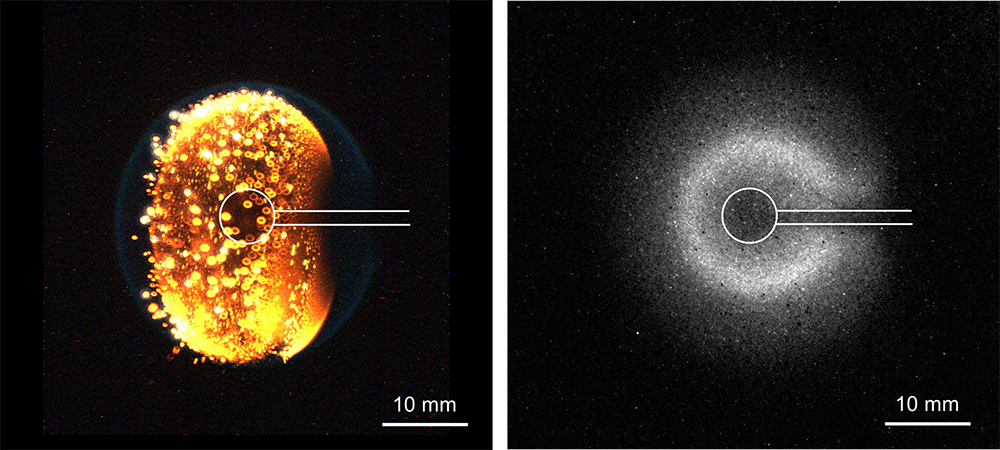Unusual "cool flames" discovered aboard International Space Station
An entirely new class of fire, spherical cool diffusion flames or simply “cool flames,” has been documented aboard the International Space Station. The discovery of these dim, quiet flames—led by fire protection engineer Peter Sunderland at the University of Maryland (UMD)—could literally ignite development of the combustion engine of the future. “This discovery transforms our understanding of what fire can be and what it can do,” said Sunderland, a professor in UMD’s A. James Clark School of Engineering. “The goal of our research is to understand the particular processes ongoing in spherical cool diffusion flames. If we can understand and model how they work, then we might be able to harness cool flames to design a new class of clean combustion engine.” Cool flames are aptly named: They burn at extremely low temperatures and emit a near-invisible blue glow. (For comparison, a natural gas burner at high heat on a conventional stove top can burn at around 3100 degrees Fahrenheit/2000 Kelvin; a typical cool flame hovers around 900 degrees Fahrenheit/800 Kelvin.) They are also somewhat mysterious: As recently as 10 years ago, cool flames had only been theoretically predicted. First observed during an experiment aboard the International Space Station (ISS) in 2012, the cool flames appeared only briefly before the liquid fuel was depleted. The sighting catalyzed an emerging, rapidly growing field in combustion research. “Little is known about combustion chemistry at these temperatures,” Sunderland explained. “Part of what we’re learning is how much we didn’t know.” To advance fundamental understanding of the nature of cool diffusion flames, Sunderland and his collaborators, including Richard Axelbaum at Washington University in St. Louis and Forman Williams at the University of California, San Diego, launched to the ISS in late 2020 an experiment designed to generate controlled cool flames that burn, steadily, for at least two minutes. In a first for microgravity flame research, they achieved this feat—with the help of astronauts aboard the ISS testing a variety of gas fuels—on June 23, 2021. UMD graduate student Minhyeng Kim observed in experiment data something unusual: After the hot flames extinguished and disappeared from camera view, heat was still being produced. The cool flames were so dim that sensitive cameras initially revealed nothing. UMD graduate student Kendyl Waddell then enhanced camera footage to reveal the astounding behavior that, after the hot flame extinguished and all reactions ceased, residual heat reignited the flowing fuel as a steady spherical cool diffusion flame. This is the first time spherical cool diffusion flames have been observed burning gaseous fuels. “This is a significant advance in the understanding of cool flames, and we are excited to see these experimental results,” said NASA’s Glenn Research Center scientist Daniel Dietrich. “The discovery of steady non-premixed cool flames will allow a more detailed study of cool flames and their chemistry.” Sunderland and Axelbaum say the immediately obvious application of cool flames would be in a new type of engine that employs a homogeneous-charge compression-ignition (HCCI) strategy. If cool flame chemistry were better understood, it could be used as a kind of catalyst to control the timing of higher-temperature combustion. Though he acknowledges there are many links between the results of the foundational science experiments aboard the ISS and how the data may actually benefit automotive engine design, Sunderland said that the ability to create a complete and working computer model of cool flame generation is a key aim. “It could be the missing link,” said Sunderland. “If we get good measurements, then we could get a model that works in a simple system; automakers may be able to take that to study other factors, or incorporate it into more complex models to improve ignition in their engines.” The experiments were performed as part of the Cool Flames Investigation with Gases (CFI-G) project, which is supported by NSF, NASA, and CASIS. The NASA Project Scientist is Dennis Stocker. Additional reading: Unlocking the Mysteries of Fire ... in Space The video below shows a hot flame created during a test for the Cool Flames Investigation with Gases experiment burning. After the flame appears to extinguish, a cool flame is created. While too faint to be visible in real time during space station testing, the research team uncovered the presence of cool flames in the data.
July 15, 2021 Prev Next |
|


